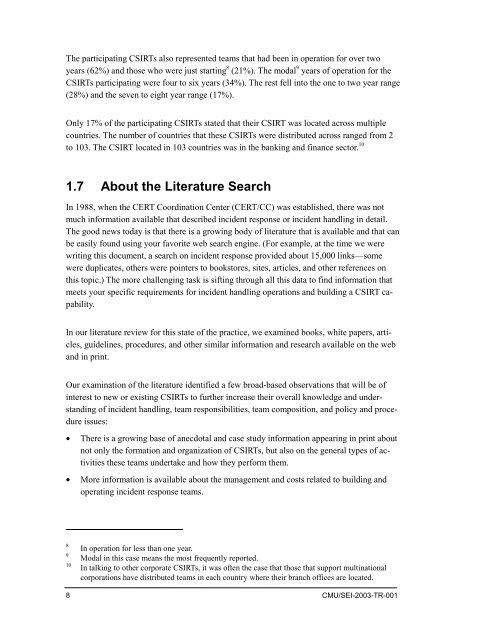State of the Practice of Computer Security Incident Response Teams ...
State of the Practice of Computer Security Incident Response Teams ...
State of the Practice of Computer Security Incident Response Teams ...
You also want an ePaper? Increase the reach of your titles
YUMPU automatically turns print PDFs into web optimized ePapers that Google loves.
The participating CSIRTs also represented teams that had been in operation for over two<br />
years (62%) and those who were just starting 8 (21%). The modal 9 years <strong>of</strong> operation for <strong>the</strong><br />
CSIRTs participating were four to six years (34%). The rest fell into <strong>the</strong> one to two year range<br />
(28%) and <strong>the</strong> seven to eight year range (17%).<br />
Only 17% <strong>of</strong> <strong>the</strong> participating CSIRTs stated that <strong>the</strong>ir CSIRT was located across multiple<br />
countries. The number <strong>of</strong> countries that <strong>the</strong>se CSIRTs were distributed across ranged from 2<br />
to 103. The CSIRT located in 103 countries was in <strong>the</strong> banking and finance sector. 10<br />
1.7 About <strong>the</strong> Literature Search<br />
In 1988, when <strong>the</strong> CERT Coordination Center (CERT/CC) was established, <strong>the</strong>re was not<br />
much information available that described incident response or incident handling in detail.<br />
The good news today is that <strong>the</strong>re is a growing body <strong>of</strong> literature that is available and that can<br />
be easily found using your favorite web search engine. (For example, at <strong>the</strong> time we were<br />
writing this document, a search on incident response provided about 15,000 links—some<br />
were duplicates, o<strong>the</strong>rs were pointers to bookstores, sites, articles, and o<strong>the</strong>r references on<br />
this topic.) The more challenging task is sifting through all this data to find information that<br />
meets your specific requirements for incident handling operations and building a CSIRT capability.<br />
In our literature review for this state <strong>of</strong> <strong>the</strong> practice, we examined books, white papers, articles,<br />
guidelines, procedures, and o<strong>the</strong>r similar information and research available on <strong>the</strong> web<br />
and in print.<br />
Our examination <strong>of</strong> <strong>the</strong> literature identified a few broad-based observations that will be <strong>of</strong><br />
interest to new or existing CSIRTs to fur<strong>the</strong>r increase <strong>the</strong>ir overall knowledge and understanding<br />
<strong>of</strong> incident handling, team responsibilities, team composition, and policy and procedure<br />
issues:<br />
• There is a growing base <strong>of</strong> anecdotal and case study information appearing in print about<br />
not only <strong>the</strong> formation and organization <strong>of</strong> CSIRTs, but also on <strong>the</strong> general types <strong>of</strong> activities<br />
<strong>the</strong>se teams undertake and how <strong>the</strong>y perform <strong>the</strong>m.<br />
• More information is available about <strong>the</strong> management and costs related to building and<br />
operating incident response teams.<br />
8<br />
9<br />
10<br />
In operation for less than one year.<br />
Modal in this case means <strong>the</strong> most frequently reported.<br />
In talking to o<strong>the</strong>r corporate CSIRTs, it was <strong>of</strong>ten <strong>the</strong> case that those that support multinational<br />
corporations have distributed teams in each country where <strong>the</strong>ir branch <strong>of</strong>fices are located.<br />
8 CMU/SEI-2003-TR-001
















